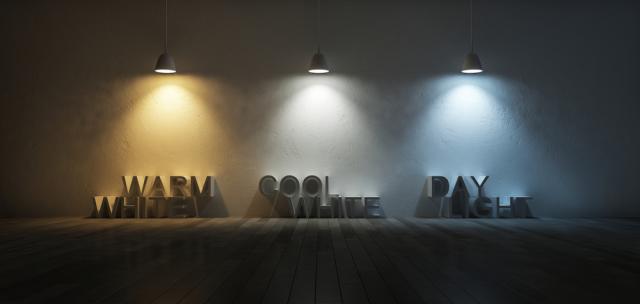Light definitely affects Color. When you go into a space with natural light streaming in, you will see vibrant colors. When you go back into the same space in the late afternoon, you may notice that the colors have lost their intensity. This is what Bea talks about in the video.
Light Temperature and Color
Bea also talks about artificial light.
Light Temperature affects how we feel in a space. You may have noticed that restaurants choose warm light to create an inviting mood, while schools choose cool lighting to keep us alert.
When you go to a home depot to buy a bulb in a specific wattage, chances are store personnel will ask you if you want warm white, cool (or natural) white, or daylight.
Allow me to be a little bit nerdy here and introduce Kelvin (K), a unit of absolute temperature that measures color temperature. Generally, the standard ranges for color temperature of the American National Standards Institute (ANSI) and the Illuminating Engineering Society (IES) are as follows:
- Warm white: 2700K-3000K
- Cool or natural white: 3500K-4100K
- Daylight: 5000K-6500K
Daylight with a clear sky is pegged at 5000-6500K.
Knowing these ranges are not so important to homeowners per se, but definitely important to lighting designers who are responsible for designing functional and beautiful lighting plans to enhance the architecture and interior design of living spaces.
Since most of us can’t afford lighting designers, we can always go with the feeling we get with the light source we have in a room. The lower the color temperature, the more cozy it feels. Here’s a rough guide:
- Warm white: Use in bedrooms or living rooms where you want to create a relaxing and inviting vibe.
- Cool or natural white: Use in home offices to increase focus and improve productivity.
- Daylight: Use in task lights like those focused lighting you need in the kitchen, bathroom, and in home offices.
Why Color Sampling is Important
Metamerism is when two colors match under one light source but look different under another. There’s an informative post about this. Just click on the image.
Metamerism: What It is and Why It’s Important in Choosing Colors
Light temperatures affect how we see colors.
This is the main reason why we highly recommend to those planning to (re)paint their rooms to buy samples of their possible colors first and Paint portions of the walls. A good size for the paint swatches would be 1 foot by 1 foot. Paint your swatches on the wall close to each other. Then visit the room several times a day to see how the color changes. Especially in the evening, when the artificial lights are on, you will see the effect of light on the paint color.
The good thing is that we have 200 mL paint pots available for this task. To get them, go to The Color Library at the MOA Square Level 2, SM Mall of Asia Complex, or click here to go directly to the Boysen online shop for 200 mL Boysen color samples.
The Color Library is also the place for you to see the paint color changing under the different light sources available. We also have this tool available in the Boysen exhibits.
Follow this blog to know more about painting tips, paint colors, and DIY hacks.
The post Light Temperature and Paint Color appeared first on MyBoysen.

